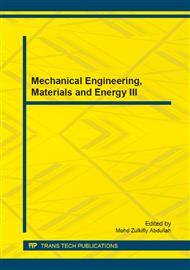p.162
p.166
p.170
p.174
p.177
p.182
p.186
p.194
p.199
A Surface Roughness Model in Radial-Mode Abrasive Waterjet Turning for High-Tensile Steels
Abstract:
Abrasive waterjet (AWJ) machining is an emerging machining method to process all kinds of difficult-to-cut materials. In this paper, a mathematical model for the surface roughness generated by a radial-mode AWJ turning process on a high-tensile steel specimen is developed using a dimensional analysis technique. To verify the model, a series of statistically designed experiments are carried out where feed speed, water pressure, abrasive flow rate, nozzle tilt angle, and workpiece surface speed are considered as variables. The model predictions are found to be in good agreement with the experimental results with the average error of 4.3%. Future research to advance the knowledge about this new machining process is also proposed.
Info:
Periodical:
Pages:
177-181
Citation:
Online since:
December 2013
Authors:
Price:
Сopyright:
© 2014 Trans Tech Publications Ltd. All Rights Reserved
Share:
Citation:


